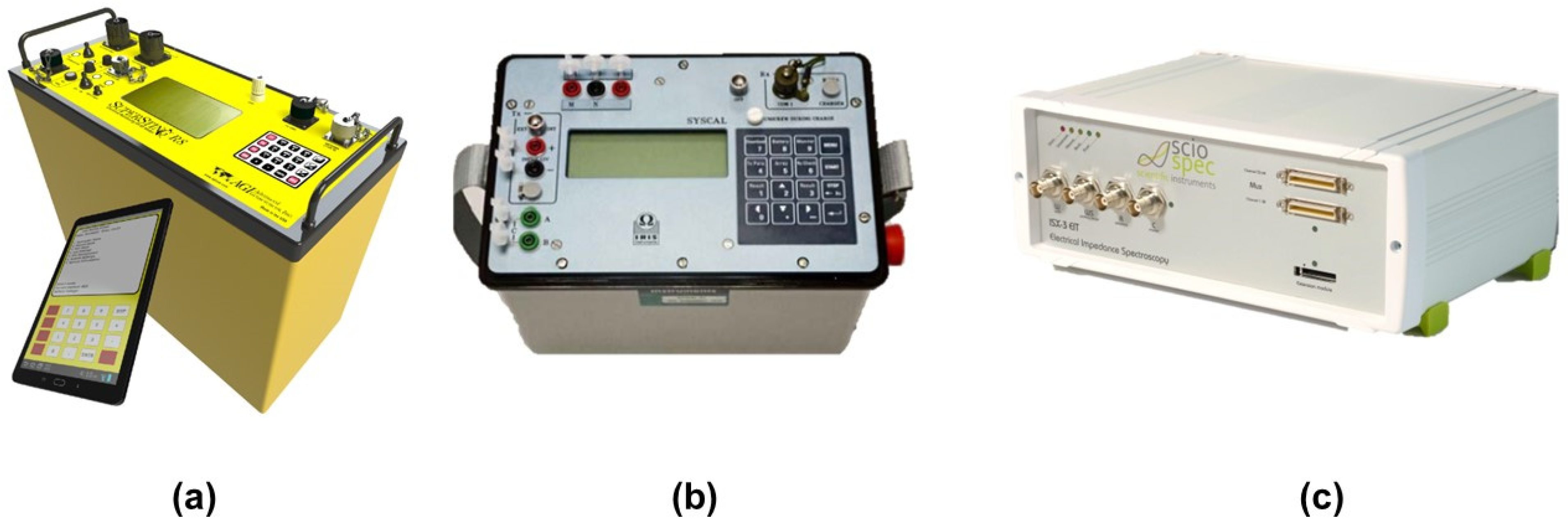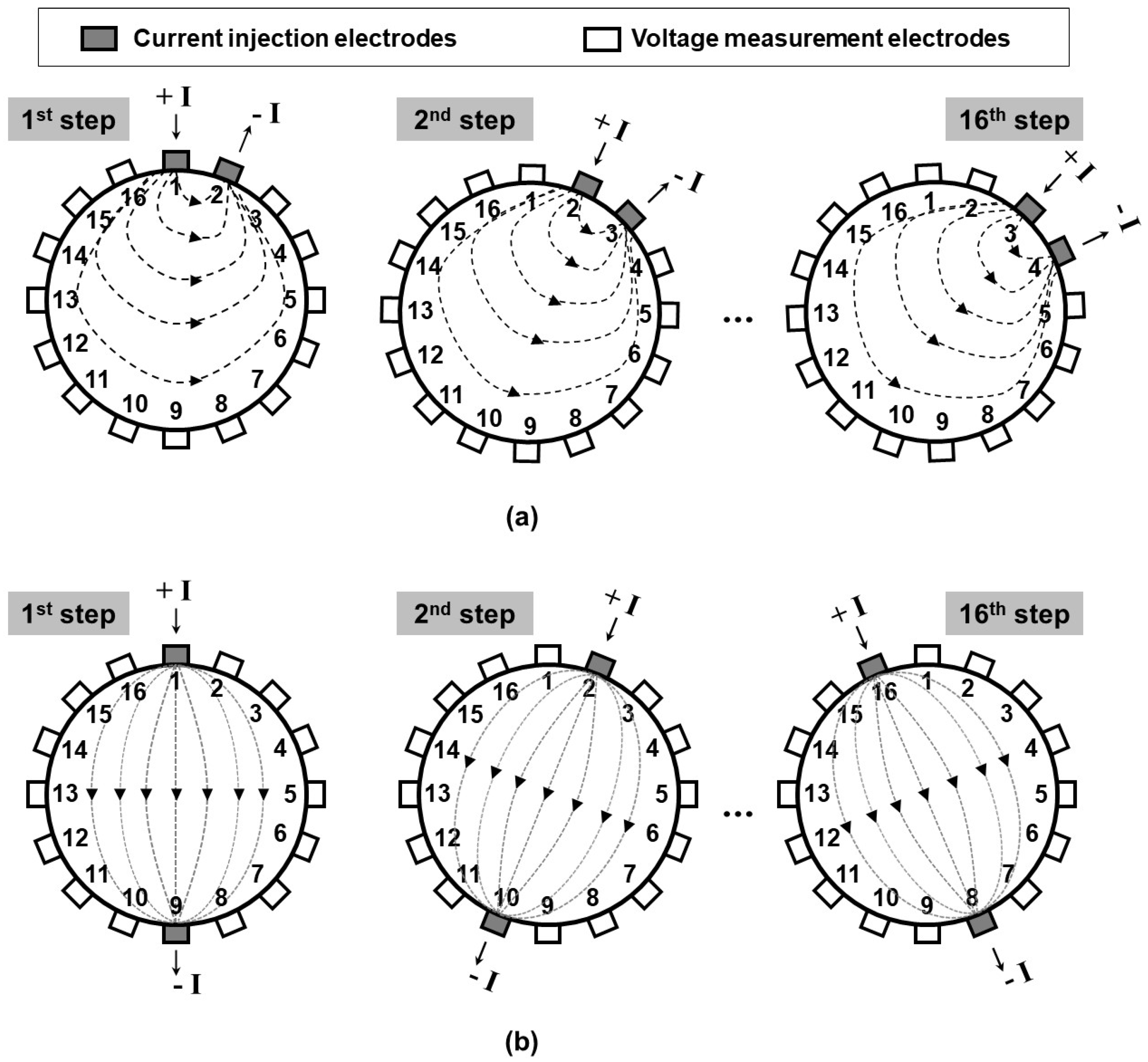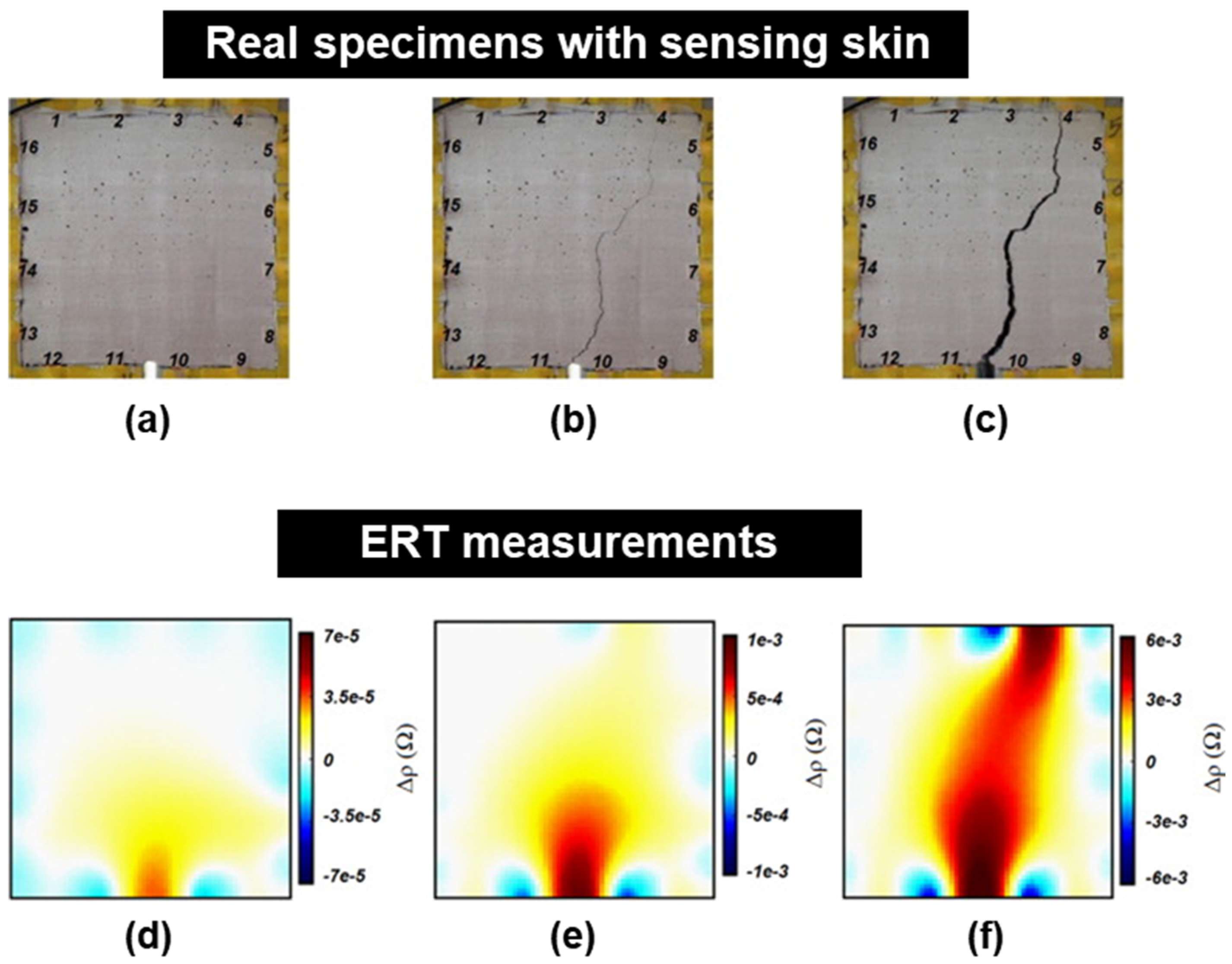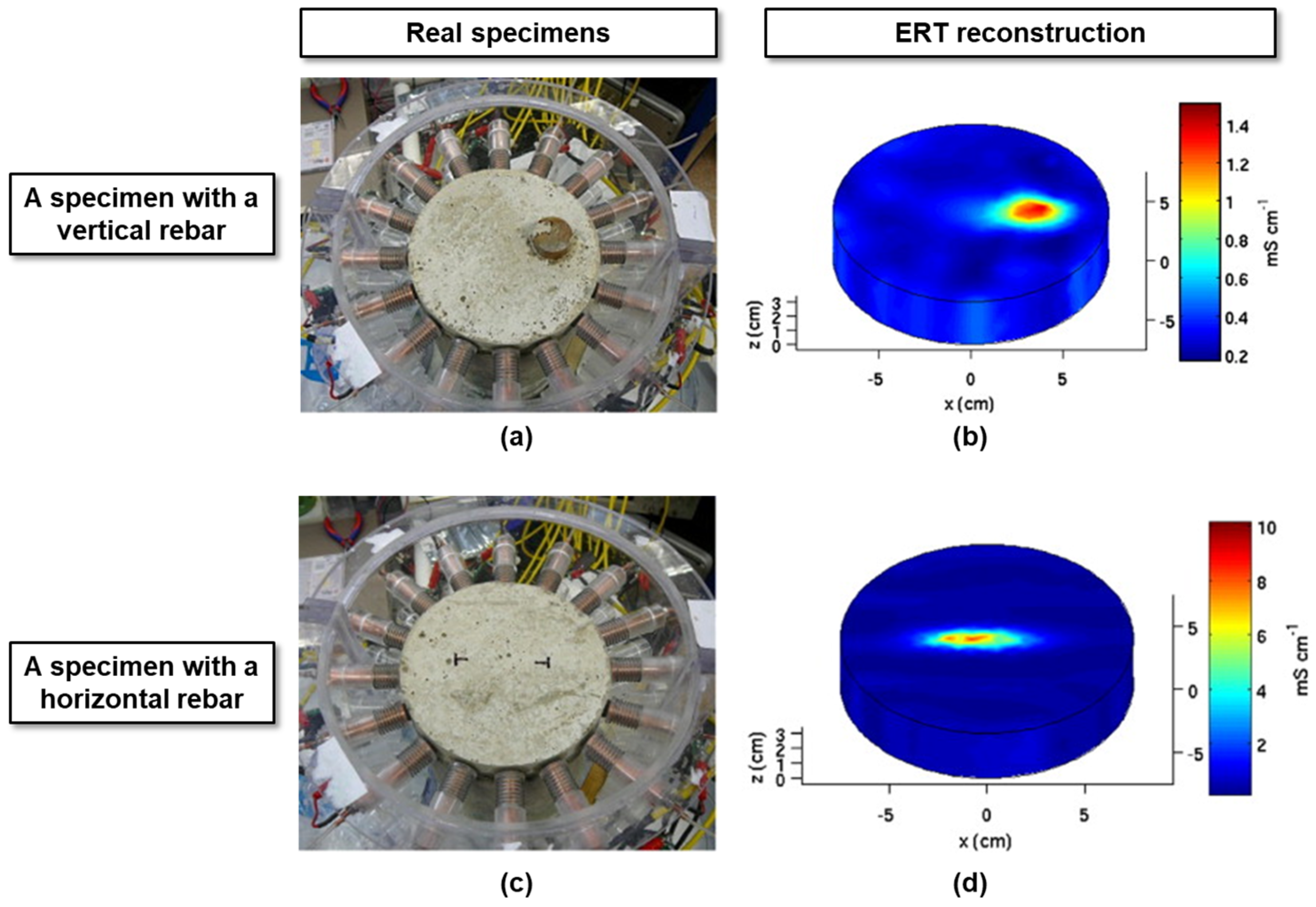Electrical Resistance Tomography (ERT) for Concrete Structure Applications: A Review
Abstract
1. Introduction
2. Fundamentals of Electrical Resistance Tomography for Concrete
2.1. Forward Problem
2.2. Inverse Schemes for Reconstruction
2.3. Measurements
3. Applications of ERT on Concrete Materials and Structures
3.1. Crack Imaging
3.2. Moisture Penetration/Water Ingress
3.3. Steel Reinforcement
3.4. Chloride Profile
4. Comparison of Current NDT and ERT
5. Recent Advances in ERT
5.1. Time-Lapse Electrical Resistivity Tomography (TL-ERT)
5.2. Integration of ERT and GPR in Geotechnical Monitoring
5.3. Challenges and Solutions in ERT for Contaminated Sites
5.4. Innovations in ERT Image Reconstruction and Flaw Detection
5.5. Advanced Techniques for ERT Image Enhancement and Process Monitoring
5.6. ERT for Structural Health Monitoring and Damage Detection
6. Challenges and Future Directions
- Development of Concrete-Compatible Electrodes for Enhanced Resolution: One of the primary challenges in ERT is enhancing resolution, particularly in concrete structures where traditional electrodes may not provide optimal performance. Research efforts should focus on the development of novel electrode materials that are suitable for concrete and that can facilitate improved resolution in ERT imaging. These electrodes should exhibit superior conductivity, stability, and compatibility with the harsh environmental conditions often encountered in concrete structures.
- Resolution Enhancement Using Artificial Intelligence Technologies: The integration of artificial intelligence (AI) technologies, such as CNNs and long short-term memory (LSTM) networks, has immense potential for enhancing the resolution of ERT imaging. By leveraging the capabilities of AI, it becomes possible to analyze subtle features indicative of structural anomalies or defects more effectively. Research in this area should focus on developing AI algorithms tailored specifically for the interpretation of ERT data, thereby improving the accuracy and resolution of ERT imaging outcomes.
- Integration with Other NDT Techniques: In addition to CNNs and LSTMs, other AI-based techniques can be applied to integrate ERT with complementary NDT methods, such as ultrasonic tomography and GPR. By combining multiple NDT techniques through AI-driven data fusion and analysis, a more sophisticated assessment of structural integrity and conditions can be achieved. This integrated approach enhances the reliability and accuracy of defect detection and characterization in various types of structures.
- Application in Large-Scale RC Structures: While ERT has been extensively applied in laboratory settings and smaller-scale field applications, its utilization in large-scale RC structures remains relatively limited. Research efforts should focus on adapting ERT techniques for practical deployment in large-scale structures, such as bridges, dams, and high-rise buildings. Addressing the challenges associated with scaling up ERT applications will facilitate broader adoption in civil engineering and infrastructure monitoring projects.
- Development of Macro-CT for Large Structures Inaccessible to X-ray CT: Macro-computed tomography (macro-CT) emerges as a promising solution for imaging large structures where traditional X-ray CT techniques are impractical or infeasible. Macro-CT utilizes alternative imaging modalities of ERT to penetrate dense materials and capture internal structural details on a macroscopic scale. Research endeavors should focus on advancing macro-CT methodologies, instrumentation, and image reconstruction algorithms to address the unique challenges posed by large-scale structural imaging requirements.
7. Conclusions
Author Contributions
Funding
Data Availability Statement
Acknowledgments
Conflicts of Interest
References
- Qu, F.; Li, W.; Dong, W.; Tam, V.W.Y.; Yu, T. Durability deterioration of concrete under marine environment from material to structure: A critical review. J. Build. Eng. 2021, 35, 102074. [Google Scholar] [CrossRef]
- Mather, B. Concrete durability. Cem. Concr. Compos. 2004, 26, 3–4. [Google Scholar] [CrossRef]
- Torres-Machi, C.; Pellicer, E.; Yepes, V.; Chamorro, A. Towards a sustainable optimization of pavement maintenance programs under budgetary restrictions. J. Clean. Prod. 2017, 148, 90–102. [Google Scholar] [CrossRef]
- Cui, Q.; Johnson, P.W.; Sees, E. Long-Term Warranties on Highway Projects; University Transportation Center for Alabama: Tuscaloosa, AL, USA, 2008. [Google Scholar]
- Matthews, S.; Morlidge, J. Achieving durable repaired concrete structures: A performance-based approach. Proc. Inst. Civ. Eng.-Struct. Build. 2008, 161, 17–28. [Google Scholar] [CrossRef]
- Hoła, J.; Schabowicz, K. State-of-the-art non-destructive methods for diagnostic testing of building structures—Anticipated development trends. Arch. Civ. Mech. Eng. 2010, 10, 5–18. [Google Scholar] [CrossRef]
- Cheney, M.; Isaacson, D.; Newell, J.C. Electrical impedance tomography. SIAM Rev. 1999, 41, 85–101. [Google Scholar] [CrossRef]
- Osinowo, O.O.; Falufosi, M.O.; Omiyale, E.O. Integrated electromagnetic (EM) and Electrical Resistivity Tomography (ERT) geophysical studies of environmental impact of Awotan dumpsite in Ibadan, southwestern Nigeria. J. Afr. Earth Sci. 2018, 140, 42–51. [Google Scholar] [CrossRef]
- Harikumar, R.; Prabu, R.; Raghavan, S. Electrical impedance tomography (EIT) and its medical applications: A review. Int. J. Soft Comput. Eng. 2013, 3, 193–198. [Google Scholar]
- Reichling, K.; Raupach, M.; Klitzsch, N. Determination of the distribution of electrical resistivity in reinforced concrete structures using electrical resistivity tomography. Mater. Corros. 2015, 66, 763–771. [Google Scholar] [CrossRef]
- Sharifi, M.; Young, B. Electrical resistance tomography (ERT) applications to chemical engineering. Chem. Eng. Res. Des. 2013, 91, 1625–1645. [Google Scholar] [CrossRef]
- Buettner, M.; Ramirez, A.; Daily, W. Electrical resistance tomography for imaging concrete structures. In Structural Materials Technology; CRC Press: Boca Raton, FL, USA, 2020; pp. 299–304. [Google Scholar]
- Chen, L.; Gallet, A.; Huang, S.-S.; Liu, D.; Smyl, D. Probabilistic cracking prediction via deep learned electrical tomography. Struct. Health Monit. 2022, 21, 1574–1589. [Google Scholar] [CrossRef]
- Quqa, S.; Landi, L.; Loh, K.J. Crack identification using electrical impedance tomography and transfer learning. Comput.-Aided Civ. Infrastruct. Eng. 2023, 38, 2426–2442. [Google Scholar] [CrossRef]
- Karhunen, K.; Seppänen, A.; Lehikoinen, A.; Monteiro, P.J.M.; Kaipio, J.P. Electrical resistance tomography imaging of concrete. Cem. Concr. Res. 2010, 40, 137–145. [Google Scholar] [CrossRef]
- Webster, J.G. Electrical Impedance Tomography; CRC Press: Boca Raton, FL, USA, 1990. [Google Scholar]
- Ma, E. A current-based forward solver for the shunt model of electrical impedance tomography. In Proceedings of the 8th European Medical and Biological Engineering Conference EMBEC 2020, Portorož, Slovenia, 29 November–3 December 2020; Springer: Berlin/Heidelberg, Germany, 2021; pp. 1–9. [Google Scholar]
- Ma, E. Integral formulation of the complete electrode model of electrical impedance tomography. Inverse Probl. Imaging 2020, 14, 385. [Google Scholar] [CrossRef]
- Yoon, S.; Jeon, D.; Oh, J.-E.; Kim, M.-K.; Kim, D.-J. Experimentally validated analytical solutions to homogeneous problems of electrical impedance tomography (EIT) on rectangular cement-based materials. Appl. Sci. 2022, 13, 335. [Google Scholar] [CrossRef]
- Yoon, S.; Kim, M.K.; Kim, T.U.; Jeon, D.; Song, H.; Suh, J.-I.; Oh, J.E.; Kim, D.J. Enhancing image resolution in single-side electrical resistance tomography (ERT) by utilizing theoretical sensitivity analysis: Experimental validation and application to cement mortar. J. Build. Eng. 2024, 84, 108480. [Google Scholar] [CrossRef]
- Tiwari, V.K.; Meribout, M.; Khezzar, L.; Alhammadi, K.; Tarek, M. Electrical tomography hardware systems for real-time applications: A review. IEEE Access 2022, 10, 93933–93950. [Google Scholar] [CrossRef]
- Fouchard, A.; Bonnet, S.; Hervé, L.; David, O. Flexible numerical platform for electrical impedance tomography. In Proceedings of the COMSOL Conference, Grenoble, France, 14–16 October 2015. [Google Scholar]
- Madenci, E.; Guven, I. The Finite Element Method and Applications in Engineering Using ANSYS®; Springer: Berlin/Heidelberg, Germany, 2015. [Google Scholar]
- Adler, A.; Lionheart, W.R.B. Uses and abuses of EIDORS: An extensible software base for EIT. Physiol. Meas. 2006, 27, S25. [Google Scholar] [CrossRef]
- Sylvester, J.; Uhlmann, G. A uniqueness theorem for an inverse boundary value problem in electrical prospection. Commun. Pure Appl. Math. 1986, 39, 91–112. [Google Scholar] [CrossRef]
- Onur, O.; Eyi, S. Effects of the Jacobian evaluation on Newton’s solution of the Euler equations. Int. J. Numer. Methods Fluids 2005, 49, 211–231. [Google Scholar] [CrossRef]
- Gómez-Laberge, C.; Adler, A. Direct EIT Jacobian calculations for conductivity change and electrode movement. Physiol. Meas. 2008, 29, S89. [Google Scholar] [CrossRef]
- Smyl, D.; Pour-Ghaz, M.; Seppänen, A. Detection and reconstruction of complex structural cracking patterns with electrical imaging. NDT E Int. 2018, 99, 123–133. [Google Scholar] [CrossRef]
- Sarode, V.; Patkar, S.; Cheeran, A.N. Comparison of 2-D algorithms in ElT based image reconstruction. Int. J. Comput. Appl. 2013, 69, 6–11. [Google Scholar] [CrossRef]
- Jeon, D.; Kim, M.K.; Woo, H.; Jeong, Y.; Oh, J.E.; Kim, D.J.; Yoon, S. Detecting embedded rebar in cement mortar by frequency-difference electrical resistance tomography. Autom. Constr. 2021, 132, 103974. [Google Scholar] [CrossRef]
- Perrone, A.; Lapenna, V.; Piscitelli, S. Electrical resistivity tomography technique for landslide investigation: A review. Earth Sci. Rev. 2014, 135, 65–82. [Google Scholar] [CrossRef]
- Bernard, J.; Leite, O.; Vermeersch, F.; Instruments, I.; Orleans, F. Multi-Electrode Resistivity Imaging for Environmental and Mining Applications; IRIS Instruments: Orleans, France, 2006. [Google Scholar]
- Bodenstein, M.; David, M.; Markstaller, K. Principles of electrical impedance tomography and its clinical application. Crit. Care Med. 2009, 37, 713–724. [Google Scholar] [CrossRef]
- Smyl, D. Electrical tomography for characterizing transport properties in cement-based materials: A review. Constr. Build. Mater. 2020, 244, 118299. [Google Scholar] [CrossRef]
- Tidswell, T.; Gibson, A.; Bayford, R.H.; Holder, D.S. Three-dimensional electrical impedance tomography of human brain activity. Neuroimage 2001, 13, 283–294. [Google Scholar] [CrossRef]
- Jeon, D.; Kim, M.K.; Jeong, Y.; Oh, J.E.; Moon, J.; Kim, D.J.; Yoon, S. High-accuracy rebar position detection using deep learning–based frequency-difference electrical resistance tomography. Autom. Constr. 2022, 135, 104116. [Google Scholar] [CrossRef]
- Rymarczyk, T.; Kłosowski, G.; Kozłowski, E. A non-destructive system based on electrical tomography and machine learning to analyze the moisture of buildings. Sensors 2018, 18, 2285. [Google Scholar] [CrossRef] [PubMed]
- Rymarczyk, T.; Kłosowski, G.; Hoła, A.; Hoła, J.; Sikora, J.; Tchórzewski, P.; Skowron, Ł. Historical buildings dampness analysis using electrical tomography and machine learning algorithms. Energies 2021, 14, 1307. [Google Scholar] [CrossRef]
- Lapenna, V.; Perrone, A. Time-lapse electrical resistivity tomography (TL-ERT) for landslide monitoring: Recent advances and future directions. Appl. Sci. 2022, 12, 1425. [Google Scholar] [CrossRef]
- Mauriello, P.; Patella, D. A data-adaptive probability-based fast ERT inversion method. Prog. Electromagn. Res. 2009, 97, 275–290. [Google Scholar] [CrossRef]
- Teniou, S.; Meribout, M. A multimodal image reconstruction method using ultrasonic waves and electrical resistance tomography. IEEE Trans. Image Process. 2015, 24, 3512–3521. [Google Scholar] [CrossRef] [PubMed]
- Aleardi, M.; Vinciguerra, A.; Hojat, A. A geostatistical Markov chain Monte Carlo inversion algorithm for electrical resistivity tomography. Near Surf. Geophys. 2021, 19, 7–26. [Google Scholar] [CrossRef]
- Ramirez, A.L.; Nitao, J.J.; Hanley, W.G.; Aines, R.; Glaser, R.E.; Sengupta, S.K.; Dyer, K.M.; Hickling, T.L.; Daily, W.D. Stochastic inversion of electrical resistivity changes using a Markov Chain Monte Carlo approach. J. Geophys. Res. Solid. Earth 2005, 110, B02101. [Google Scholar] [CrossRef]
- Gupta, S.; Lin, Y.-A.; Lee, H.-J.; Buscheck, J.; Wu, R.; Lynch, J.P.; Garg, N.; Loh, K.J. In situ crack mapping of large-scale self-sensing concrete pavements using electrical resistance tomography. Cem. Concr. Compos. 2021, 122, 104154. [Google Scholar] [CrossRef]
- Karhunen, K.; Seppänen, A.; Lehikoinen, A.; Blunt, J.; Kaipio, J.P.; Monteiro, P.J.M. Electrical Resistance Tomography for Assessment of Cracks in Concrete. ACI Mater. J. 2010, 107, 523. [Google Scholar]
- Zhou, X.; Bhat, P.; Ouyang, H.; Yu, J. Localization of cracks in cementitious materials under uniaxial tension with electrical resistance tomography. Constr. Build. Mater. 2017, 138, 45–55. [Google Scholar] [CrossRef]
- Ren, H.; Tian, K.; Hong, S.; Dong, B.; Xing, F.; Qin, L. Visualized investigation of defect in cementitious materials with electrical resistance tomography. Constr. Build. Mater. 2019, 196, 428–436. [Google Scholar] [CrossRef]
- Hallaji, M.; Pour-Ghaz, M. A new sensing skin for qualitative damage detection in concrete elements: Rapid difference imaging with electrical resistance tomography. NDT E Int. 2014, 68, 13–21. [Google Scholar] [CrossRef]
- McAlorum, J.; Perry, M.; Ward, A.C.; Vlachakis, C. ConcrEITS: An electrical impedance interrogator for concrete damage detection using self-sensing repairs. Sensors 2021, 21, 7081. [Google Scholar] [CrossRef] [PubMed]
- Hallaji, M.; Seppänen, A.; Pour-Ghaz, M. Electrical resistance tomography to monitor unsaturated moisture flow in cementitious materials. Cem. Concr. Res. 2015, 69, 10–18. [Google Scholar] [CrossRef]
- Smyl, D.; Rashetnia, R.; Seppänen, A.; Pour-Ghaz, M. Can electrical resistance tomography be used for imaging unsaturated moisture flow in cement-based materials with discrete cracks? Cem. Concr. Res. 2017, 91, 61–72. [Google Scholar] [CrossRef]
- Suryanto, B.; Saraireh, D.; Kim, J.; McCarter, W.J.; Starrs, G.; Taha, H.M. Imaging water ingress into concrete using electrical resistance tomography. Int. J. Adv. Eng. Sci. Appl. Math. 2017, 9, 109–118. [Google Scholar] [CrossRef]
- Voss, A.; Hänninen, N.; Pour-Ghaz, M.; Vauhkonen, M.; Seppänen, A. Imaging of two-dimensional unsaturated moisture flows in uncracked and cracked cement-based materials using electrical capacitance tomography. Mater. Struct. 2018, 51, 68. [Google Scholar] [CrossRef]
- Caetano, T.R.; Santos, H.A.; van Dam, R.L. Leak identification in non-pressurized concrete pipelines by the use of geophysical methods. J. Appl. Geophy 2023, 208, 104883. [Google Scholar] [CrossRef]
- Wang, W.; Zhao, K.; Zhang, P.; Bao, J.; Xue, S. Investigation of water ingress into uncracked and cracked cement-based materials using electrical capacitance volume tomography. Mater. Des. 2022, 220, 110877. [Google Scholar] [CrossRef]
- Buettner, M.; Ramirez, A.; Daily, W. Electrical resistance tomography for imaging the spatial distribution of moisture in pavement sections. In Structural Materials Technology; CRC Press: Boca Raton, FL, USA, 2020; pp. 342–347. [Google Scholar]
- Zhou, X.; Wang, J.; Tu, F.; Bhat, P. Damage detection in cementitious materials with optimized absolute electrical resistance tomography. Struct. Health Monit. 2022, 21, 2420–2435. [Google Scholar] [CrossRef]
- Wang, W.; Zhang, P.; Yang, D.; Xue, S. Imaging of unsaturated moisture flow inside cracked porous brick using electrical capacitance volume tomography. J. Build. Eng. 2023, 64, 105626. [Google Scholar] [CrossRef]
- Kuen, J.; Woo, E.J.; Seo, J.K. Multi-frequency time-difference complex conductivity imaging of canine and human lungs using the KHU Mark1 EIT system. Physiol. Meas. 2009, 30, S149–S164. [Google Scholar] [CrossRef]
- Ahn, S.; Jun, S.C.; Seo, J.K.; Lee, J.; Woo, E.J.; Holder, D. Frequency-difference electrical impedance tomography: Phantom imaging experiments. J. Phys. Conf. Ser. 2010, 224, 012152. [Google Scholar] [CrossRef]
- Karhunen, K.; Seppänen, A.; Lehikoinen, A.; Kaipio, J.P.; Monteiro, P.J.M. Locating reinforcing bars in concrete with electrical resistance tomography. In Concrete Repair, Rehabilitation and Retrofitting II; Alexander, M.G., Beushausen, H.-D., Dehn, F., Moyo, P., Eds.; Taylor & Francis Group: London, UK, 2009. [Google Scholar]
- Alhajj, M.A.; Palma-Lopes, S.; Villain, G. Accounting for steel rebar effect on resistivity profiles in view of reinforced concrete structure survey. Constr. Build. Mater. 2019, 223, 898–909. [Google Scholar] [CrossRef]
- Taghizadieh, N.; Movahedi, S. Numerical Meshless Method in Conjunction with Bayesian Theorem for Electrical Tomography of Concrete. Int. J. Eng. 2020, 33, 1070–1084. [Google Scholar]
- Achrafi, M.K.E.L.; Bonnet, S.; Villain, G. Electrical resistivity tomography results analyzed with two inversion methods to determine chloride profiles on BFS concrete having very high electrical resistivity. Constr. Build. Mater. 2023, 407, 133361. [Google Scholar] [CrossRef]
- Naik, T.R.; Malhotra, V.M.; Popovics, J.S. The ultrasonic pulse velocity method. In Handbook on Nondestructive Testing of Concrete, 2nd ed.; CRC Press: Boca Raton, FL, USA, 2003; pp. 1–8. [Google Scholar]
- Carpinteri, A.; Lacidogna, G.; Niccolini, G. Damage analysis of reinforced concrete buildings by the acoustic emission technique. Struct. Control Health Monit. 2011, 18, 660–673. [Google Scholar] [CrossRef]
- Sagar, R.V.; Mohit; Deepak, S.; Desai, P.R. Statistical analysis of acoustic emissions generated during unconfined uniaxial compression of cementitious materials. Constr. Build. Mater. 2019, 225, 692–708. [Google Scholar] [CrossRef]
- Kuusela, P.; Pour-Ghaz, M.; Pini, R.; Voss, A.; Seppänen, A. Imaging of reactive transport in fractured cement-based materials with X-ray CT. Cem. Concr. Compos. 2021, 124, 104211. [Google Scholar] [CrossRef]
- Ponikiewski, T.; Gołaszewski, J.; Rudzki, M.; Bugdol, M. Determination of steel fibres distribution in self-compacting concrete beams using X-ray computed tomography. Arch. Civ. Mech. Eng. 2015, 15, 558–568. [Google Scholar] [CrossRef]
- Michel, A.; Pease, B.J.; Geiker, M.R.; Stang, H.; Olesen, J.F. Monitoring reinforcement corrosion and corrosion-induced cracking using non-destructive x-ray attenuation measurements. Cem. Concr. Res. 2011, 41, 1085–1094. [Google Scholar] [CrossRef]
- Guo, Y.; Chen, X.; Chen, B.; Wen, R.; Wu, P. Analysis of foamed concrete pore structure of railway roadbed based on X-ray computed tomography. Constr. Build. Mater. 2021, 273, 121773. [Google Scholar] [CrossRef]
- Capozzoli, L.; De Martino, G.; Polemio, M.; Rizzo, E. Geophysical Techniques for Monitoring Settlement Phenomena Occurring in Reinforced Concrete Buildings. Surv. Geophys. 2020, 41, 575–604. [Google Scholar] [CrossRef]
- Yang, L.; Yang, D.; Yuan, Q. Electrical resistivity tomography through reinforced concrete floor. Near Surf. Geophys. 2024, 22, 47–59. [Google Scholar] [CrossRef]
- Yang, L.; Yang, D.; Yuan, Q. High-resolution ERT imaging of DNAPL contamination at complex soil remediation sites. In First International Meeting for Applied Geoscience & Energy, Society of Exploration Geophysicists; Society of Exploration Geophysicists: Houston, TX, USA, 2021; pp. 1961–1965. [Google Scholar]
- Zhou, X.; Tu, F.; Wang, J.; Li, Q. Subdomain integration method of electrical resistance tomography for multiple flaws detection in cementitious materials. Struct. Health Monit. 2022, 21, 2436–2452. [Google Scholar] [CrossRef]
- Li, F.; Tan, C.; Dong, F. Electrical Resistance Tomography Image Reconstruction With Densely Connected Convolutional Neural Network. IEEE Trans. Instrum. Meas. 2021, 70, 1–11. [Google Scholar] [CrossRef]
- Jauhiainen, J.; Pour-Ghaz, M.; Valkonen, T.; Seppänen, A. Nonplanar sensing skins for structural health monitoring based on electrical resistance tomography. Comput.-Aided Civ. Infrastruct. Eng. 2021, 36, 1488–1507. [Google Scholar] [CrossRef]
- Escalona-Galvis, L.W.; Venkataraman, S. Optimum reduction of sensing electrodes for delamination identification with electrical resistance tomography. Struct. Control Health Monit. 2021, 28, e2726. [Google Scholar] [CrossRef]
- Chen, Y.; Li, K.; Han, Y. Electrical resistance tomography with conditional generative adversarial networks. Meas. Sci. Technol. 2020, 31, 055401. [Google Scholar] [CrossRef]
- Li, F.; Tan, C.; Dong, F.; Jia, J. V-Net Deep Imaging Method for Electrical Resistance Tomography. IEEE Sens. J. 2020, 20, 6460–6469. [Google Scholar] [CrossRef]
- Cimpoiaşu, M.O.; Kuras, O.; Pridmore, T.; Mooney, S.J. A pedophysical relationship between X-ray computed tomography and electrical resistivity data. J. Env. Eng. Geophys. 2020, 25, 181–187. [Google Scholar] [CrossRef]
- Hung, Y.-C.; Zhao, Y.-X.; Hung, W.-C. Development of an Underground Tunnels Detection Algorithm for Electrical Resistivity Tomography Based on Deep Learning. Appl. Sci. 2022, 12, 639. [Google Scholar] [CrossRef]
- Kong, S.; Oh, J.; Yoon, D.; Ryu, D.-W.; Kwon, H.-S. Integrating Deep Learning and Deterministic Inversion for Enhancing Fault Detection in Electrical Resistivity Surveys. Appl. Sci. 2023, 13, 6250. [Google Scholar] [CrossRef]
- Hasan, M.; Shang, Y.; Meng, H.; Shao, P.; Yi, X. Application of electrical resistivity tomography (ERT) for rock mass quality evaluation. Sci. Rep. 2021, 11, 23683. [Google Scholar] [CrossRef] [PubMed]
- Rashetnia, R.; Smyl, D.; Hallaji, M.; Seppänen, A.; Pour-Ghaz, M. Structural health monitoring using electrical resistance tomography based sensing skin: Detecting damage, corrosive elements, and temperature change. In 9th International Conference on Inverse Problems in Engineering (ICIPE): Papers; University of Waterloo: Waterloo, ON, Canada, 2017. [Google Scholar]
- Tallman, T.N.; Smyl, D.J. Structural health and condition monitoring via electrical impedance tomography in self-sensing materials: A review. Smart Mater. Struct. 2020, 29, 123001. [Google Scholar] [CrossRef]
- Serlenga, V.; Gallipoli, M.R.; Ditommaso, R.; Ponzo, C.F.; Tragni, N.; Perrone, A.; Stabile, T.A.; Calamita, G.; Vignola, L.; Carso, R.F. An integrated approach for structural behavior characterization of the Gravina Bridge (Matera, Southern Italy). Struct. Health Monit. 2021, 20, 3371–3391. [Google Scholar] [CrossRef]







Disclaimer/Publisher’s Note: The statements, opinions and data contained in all publications are solely those of the individual author(s) and contributor(s) and not of MDPI and/or the editor(s). MDPI and/or the editor(s) disclaim responsibility for any injury to people or property resulting from any ideas, methods, instructions or products referred to in the content. |
© 2024 by the authors. Licensee MDPI, Basel, Switzerland. This article is an open access article distributed under the terms and conditions of the Creative Commons Attribution (CC BY) license (https://creativecommons.org/licenses/by/4.0/).
Share and Cite
Jeon, D.; Yoon, S. Electrical Resistance Tomography (ERT) for Concrete Structure Applications: A Review. Buildings 2024, 14, 2654. https://doi.org/10.3390/buildings14092654
Jeon D, Yoon S. Electrical Resistance Tomography (ERT) for Concrete Structure Applications: A Review. Buildings. 2024; 14(9):2654. https://doi.org/10.3390/buildings14092654
Chicago/Turabian StyleJeon, Dongho, and Seyoon Yoon. 2024. "Electrical Resistance Tomography (ERT) for Concrete Structure Applications: A Review" Buildings 14, no. 9: 2654. https://doi.org/10.3390/buildings14092654
APA StyleJeon, D., & Yoon, S. (2024). Electrical Resistance Tomography (ERT) for Concrete Structure Applications: A Review. Buildings, 14(9), 2654. https://doi.org/10.3390/buildings14092654






